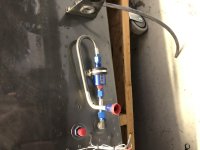claycookiemonster
Well Known Member
One of the joys of working on a really well planned Project is the little surprises you run into all the time.
It's time to get into fuel system planning and plumbing, but of course the previous builder (Kent Scherm, Ontario CA) got there before me. The Fuel pump location is ready for me, but there was no fuel filter plumbing ready at the standard location. Instead, since it was a Canadian project, he went with Gascolators.
So, I have two Andair GAS375 gascolators still in the original packaging already in hand. Given that, and I understand fuel filters are somewhat preferred for injected systems, should I just stick with gascolators in each wing root, or put them back on the shelf and go with inline filters?
It's time to get into fuel system planning and plumbing, but of course the previous builder (Kent Scherm, Ontario CA) got there before me. The Fuel pump location is ready for me, but there was no fuel filter plumbing ready at the standard location. Instead, since it was a Canadian project, he went with Gascolators.
So, I have two Andair GAS375 gascolators still in the original packaging already in hand. Given that, and I understand fuel filters are somewhat preferred for injected systems, should I just stick with gascolators in each wing root, or put them back on the shelf and go with inline filters?





